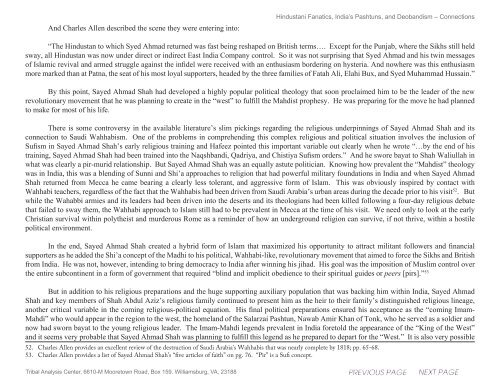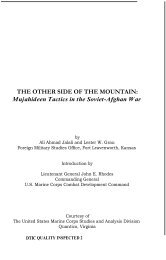hindustani fanatics, india's pashtuns, and deobandism â connections
hindustani fanatics, india's pashtuns, and deobandism â connections
hindustani fanatics, india's pashtuns, and deobandism â connections
- No tags were found...
You also want an ePaper? Increase the reach of your titles
YUMPU automatically turns print PDFs into web optimized ePapers that Google loves.
And Charles Allen described the scene they were entering into:Hindustani Fanatics, India’s Pashtuns, <strong>and</strong> Deob<strong>and</strong>ism – Connections“The Hindustan to which Syed Ahmad returned was fast being reshaped on British terms…. Except for the Punjab, where the Sikhs still heldsway, all Hindustan was now under direct or indirect East India Company control. So it was not surprising that Syed Ahmad <strong>and</strong> his twin messagesof Islamic revival <strong>and</strong> armed struggle against the infidel were received with an enthusiasm bordering on hysteria. And nowhere was this enthusiasmmore marked than at Patna, the seat of his most loyal supporters, headed by the three families of Fatah Ali, Elahi Bux, <strong>and</strong> Syed Muhammad Hussain.”By this point, Sayed Ahmad Shah had developed a highly popular political theology that soon proclaimed him to be the leader of the newrevolutionary movement that he was planning to create in the “west” to fulfill the Mahdist prophesy. He was preparing for the move he had plannedto make for most of his life.There is some controversy in the available literature’s slim pickings regarding the religious underpinnings of Sayed Ahmad Shah <strong>and</strong> itsconnection to Saudi Wahhabism. One of the problems in comprehending this complex religious <strong>and</strong> political situation involves the inclusion ofSufism in Sayed Ahmad Shah’s early religious training <strong>and</strong> Hafeez pointed this important variable out clearly when he wrote “…by the end of histraining, Sayed Ahmad Shah had been trained into the Naqshb<strong>and</strong>i, Qadriya, <strong>and</strong> Chistiya Sufism orders.” And he swore bayat to Shah Waliullah inwhat was clearly a pir-murid relationship. But Sayed Ahmad Shah was an equally astute politician. Knowing how prevalent the “Mahdist” theologywas in India, this was a blending of Sunni <strong>and</strong> Shi’a approaches to religion that had powerful military foundations in India <strong>and</strong> when Sayed AhmadShah returned from Mecca he came bearing a clearly less tolerant, <strong>and</strong> aggressive form of Islam. This was obviously inspired by contact withWahhabi teachers, regardless of the fact that the Wahhabis had been driven from Saudi Arabia’s urban areas during the decade prior to his visit 52 . Butwhile the Wahabbi armies <strong>and</strong> its leaders had been driven into the deserts <strong>and</strong> its theologians had been killed following a four-day religious debatethat failed to sway them, the Wahhabi approach to Islam still had to be prevalent in Mecca at the time of his visit. We need only to look at the earlyChristian survival within polytheist <strong>and</strong> murderous Rome as a reminder of how an underground religion can survive, if not thrive, within a hostilepolitical environment.In the end, Sayed Ahmad Shah created a hybrid form of Islam that maximized his opportunity to attract militant followers <strong>and</strong> financialsupporters as he added the Shi’a concept of the Madhi to his political, Wahhabi-like, revolutionary movement that aimed to force the Sikhs <strong>and</strong> Britishfrom India. He was not, however, intending to bring democracy to India after winning his jihad. His goal was the imposition of Muslim control overthe entire subcontinent in a form of government that required “blind <strong>and</strong> implicit obedience to their spiritual guides or peers [pirs].” 53But in addition to his religious preparations <strong>and</strong> the huge supporting auxiliary population that was backing him within India, Sayed AhmadShah <strong>and</strong> key members of Shah Abdul Aziz’s religious family continued to present him as the heir to their family’s distinguished religious lineage,another critical variable in the coming religious-political equation. His final political preparations ensured his acceptance as the “coming Imam-Mahdi” who would appear in the region to the west, the homel<strong>and</strong> of the Salarzai Pashtun, Nawab Amir Khan of Tonk, who he served as a soldier <strong>and</strong>now had sworn bayat to the young religious leader. The Imam-Mahdi legends prevalent in India foretold the appearance of the “King of the West”<strong>and</strong> it seems very probable that Sayed Ahmad Shah was planning to fulfill this legend as he prepared to depart for the “West.” It is also very possible52. Charles Allen provides an excellent review of the destruction of Saudi Arabia’s Wahhabis that was nearly complete by 1818; pp. 65-68.53. Charles Allen provides a list of Sayed Ahmad Shah’s “five articles of faith” on pg. 76. “Pir” is a Sufi concept.Tribal Analysis Center, 6610-M Mooretown Road, Box 159. Williamsburg, VA, 23188
















